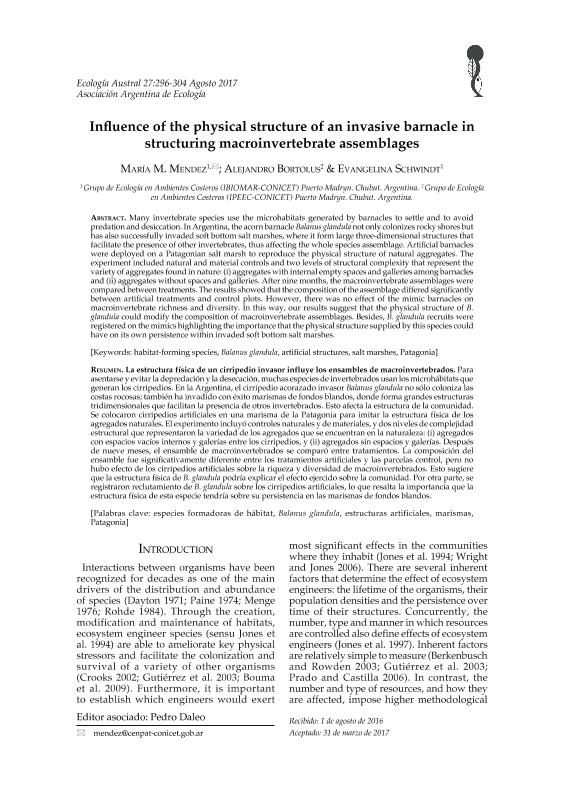Artículo
Many invertebrate species use the microhabitats generated by barnacles to settle and to avoid predation and desiccation. In Argentina, the acorn barnacle Balanus glandula not only colonizes rocky shores but has also successfully invaded soft bottom salt marshes, where it form large three-dimensional structures that facilitate the presence of other invertebrates, thus affecting the whole species assemblage. Artificial barnacles were deployed on a Patagonian salt marsh to reproduce the physical structure of natural aggregates. The experiment included natural and material controls and two levels of structural complexity that represent the variety of aggregates found in nature: (i) aggregates with internal empty spaces and galleries among barnacles and (ii) aggregates without spaces and galleries. After nine months, the macroinvertebrate assemblages were compared between treatments. The results showed that the composition of the assemblage differed significantly between artificial treatments and control plots. However, there was no effect of the mimic barnacles on macroinvertebrate richness and diversity. In this way, our results suggest that the physical structure of B. glandula could modify the composition of macroinvertebrate assemblages. Besides, B. glandula recruits were registered on the mimics highlighting the importance that the physical structure supplied by this species could have on its own persistence within invaded soft bottom salt marshes. Para asentarse y evitar la depredación y la desecación, muchas especies de invertebrados usan los microhábitats que generan los cirripedios. En la Argentina, el cirripedio acorazado invasor Balanus glandula no sólo coloniza las costas rocosas; también ha invadido con éxito marismas de fondos blandos, donde forma grandes estructuras tridimensionales que facilitan la presencia de otros invertebrados. Esto afecta la estructura de la comunidad. Se colocaron cirripedios artificiales en una marisma de la Patagonia para imitar la estructura física de los agregados naturales. El experimento incluyó controles naturales y de materiales, y dos niveles de complejidad estructural que representaron la variedad de los agregados que se encuentran en la naturaleza: a) agregados con espacios vacíos internos y galerías entre los cirripedios, y b) agregados sin espacios y galerías. Después de nueve meses, el ensamble de macroinvertebrados se comparó entre tratamientos. La composición del ensamble fue significativamente diferente entre los tratamientos artificiales y las parcelas control, pero no hubo efecto de los cirripedios artificiales sobre la riqueza y diversidad de macroinvertebrados. Esto sugiere que la estructura física de B. glandula podría explicar el efecto ejercido sobre la comunidad. Por otra parte, se registraron reclutamiento de B. glandula sobre los cirripedios artificiales, lo que resalta la importancia que la estructura física de esta especie tendría sobre su persistencia en las marismas de fondos blandos.
Influence of the physical structure of an invasive barnacle in structuring macroinvertebrate assemblages
Título:
La estructura física de un cirripedio invasor influye los ensambles de macroinvertebrados
Fecha de publicación:
08/2017
Editorial:
Asociación Argentina de Ecología
Revista:
Ecología Austral
ISSN:
1667-782X
e-ISSN:
0327-5477
Idioma:
Inglés
Tipo de recurso:
Artículo publicado
Clasificación temática:
Resumen
Archivos asociados
Licencia
Identificadores
Colecciones
Articulos(IBIOMAR)
Articulos de INSTITUTO DE BIOLOGIA DE ORGANISMOS MARINOS
Articulos de INSTITUTO DE BIOLOGIA DE ORGANISMOS MARINOS
Citación
Mendez, María Martha; Bortolus, Alejandro; Schwindt, Evangelina; Influence of the physical structure of an invasive barnacle in structuring macroinvertebrate assemblages; Asociación Argentina de Ecología; Ecología Austral; 27; 2; 8-2017; 296-304
Compartir
Altmétricas




